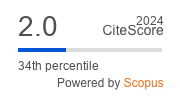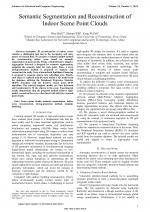| 3/2024 - 1 | View TOC | « Previous Article | Next Article » |
Semantic Segmentation and Reconstruction of Indoor Scene Point CloudsHAO, W. |
| Extra paper information in |
| Click to see author's profile in |
| Download PDF |
Author keywords
point clouds, semantic segmentation, indoor scene reconstruction, slicing-projection method, template matching
References keywords
point(28), vision(15), clouds(14), semantic(13), reconstruction(13), recognition(13), indoor(13), segmentation(12), cloud(12), pattern(11)
Blue keywords are present in both the references section and the paper title.
About this article
Date of Publication: 2024-08-31
Volume 24, Issue 3, Year 2024, On page(s): 3 - 12
ISSN: 1582-7445, e-ISSN: 1844-7600
Digital Object Identifier: 10.4316/AECE.2024.03001
Web of Science Accession Number: 001306111400001
SCOPUS ID: 85203023424
Abstract
Automatic 3D reconstruction of indoor scenes remains a challenging task due to the incomplete and noisy nature of scanned data. We propose a semantic-guided method for reconstructing indoor scene based on semantic segmentation of point clouds. Firstly, a Multi-Feature Adaptive Aggregation Network is designed for semantic segmentation, assigning the semantic label for each point. Then, a novel slicing-projection method is proposed to segment and reconstruct the walls. Next, a hierarchical Euclidean Clustering is proposed to separate objects into individual ones. Finally, each object is replaced with the most similar CAD model from the database, utilizing the Rotational Projection Statistics (RoPS) descriptor and the iterative closest point (ICP) algorithm. The selected template models are then deformed and transformed to fit the objects in the scene. Experimental results demonstrate that the proposed method achieves high-quality reconstruction even when faced with defective scanned point clouds. |
| References | | | Cited By «-- Click to see who has cited this paper |
| [1] Y. Yang et al., "Automatic 3D indoor scene modeling from single panorama," Proceedings of the IEEE Conference on Computer Vision and Pattern Recognition. 2018, 3926-3934. [CrossRef] [Web of Science Times Cited 40] [SCOPUS Times Cited 49] [2] C. Sun et al., "Indoor panorama planar 3D reconstruction via divide and conquer," Proceedings of the IEEE/CVF Conference on Computer Vision and Pattern Recognition. 2021, 11338-11347. [CrossRef] [3] L. Huan, X. Zheng, J. Gong, "GeoRec: Geometry-enhanced semantic 3D reconstruction of RGB-D indoor scenes," ISPRS Journal of Photogrammetry and Remote Sensing. 2022, 186, 301-314. [CrossRef] [Web of Science Times Cited 19] [SCOPUS Times Cited 22] [4] G. Chen et al., "Scene recognition with prototype-agnostic scene layout," IEEE Transactions on Image Processing. 2022, 29, 5877-5888. [CrossRef] [Web of Science Times Cited 51] [SCOPUS Times Cited 59] [5] M. Bassier, M. Vergauwen, "Unsupervised reconstruction of Building Information Modeling wall objects from point cloud data," Automation in construction. 2020, 120, 103338. [CrossRef] [Web of Science Times Cited 79] [SCOPUS Times Cited 89] [6] M. Kim et al., "Automated extraction of geometric primitives with solid lines from unstructured point clouds for creating digital buildings models," Automation in Construction.2023, 145, 104642. [CrossRef] [Web of Science Times Cited 18] [SCOPUS Times Cited 19] [7] Y. Guo et al., "Rotational projection statistics for 3D local surface description and object recognition," International journal of computer vision. 2013, 105, 63-86. [CrossRef] [Web of Science Times Cited 523] [SCOPUS Times Cited 636] [8] G. Pintore et al., "State-of-the-art in automatic 3D reconstruction of structured indoor environments," Computer Graphics Forum. 2020, 39(2), 667-699. [CrossRef] [Web of Science Times Cited 97] [SCOPUS Times Cited 110] [9] S. Oesau, F. Lafarge, P. Alliez, "Indoor scene reconstruction using feature sensitive primitive extraction and graph-cut," ISPRS journal of photogrammetry and remote sensing. 2014, 90, 68-82. [CrossRef] [Web of Science Times Cited 160] [SCOPUS Times Cited 207] [10] F. Yang et al., "Automatic indoor reconstruction from point clouds in multi-room environments with curved walls," Sensors. 2019, 19(17), 3798. [CrossRef] [Web of Science Times Cited 43] [SCOPUS Times Cited 49] [11] C. Fotsing et al., "Volumetric wall detection in unorganized indoor point clouds using continuous segments in 2D grids," Automation in Construction. 2022, 141, 104462. [CrossRef] [Web of Science Times Cited 16] [SCOPUS Times Cited 16] [12] Y. Cui et al., "Automatic 3-D reconstruction of indoor environment with mobile laser scanning point clouds," IEEE Journal of Selected Topics in Applied Earth Observations and Remote Sensing. 2019, 12(8): 3117-3130. [CrossRef] [SCOPUS Times Cited 1] [13] H. Fang, C. Pan, H. Huang, "Structure-aware indoor scene reconstruction via two levels of abstraction," ISPRS Journal of Photogrammetry and Remote Sensing. 2021, 178, 155-170. [CrossRef] [Web of Science Times Cited 15] [SCOPUS Times Cited 17] [14] J. Chen, Z. Kira, and Y. K. Cho, "Deep learning approach to point cloud scene understanding for automated scan to 3D reconstruction," Journal of Computing in Civil Engineering. 2019, 33(4), 04019027. [CrossRef] [Web of Science Times Cited 124] [SCOPUS Times Cited 148] [15] C. R. Qi et al., "Pointnet: Deep learning on point sets for 3d classification and segmentation," Proceedings of the IEEE conference on computer vision and pattern recognition. 2017, 1063-6919. [CrossRef] [Web of Science Times Cited 4790] [SCOPUS Times Cited 12628] [16] H. Kim, C. Kim, "3D as-built modeling from incomplete point clouds using connectivity relations," Automation in Construction. 2021, 130, 103855. [CrossRef] [Web of Science Times Cited 24] [SCOPUS Times Cited 28] [17] Y. Wang et al., "Dynamic graph CNN for learning on point clouds," ACM Transactions on Graphics (tog). 2019, 38(5), 1-12. [CrossRef] [Web of Science Times Cited 4756] [SCOPUS Times Cited 5667] [18] M. Ai, Z. Li, J. Shan, "Topologically consistent reconstruction for complex indoor structures from point clouds," Remote Sensing. 2022, 13(19), 3844. [CrossRef] [Web of Science Times Cited 8] [SCOPUS Times Cited 10] [19] C. R. Qi et al., "Pointnet++: Deep hierarchical feature learning on point sets in a metric space," Advances in neural information processing systems. 2017, 30. [CrossRef] [20] T. Wang et al., "Semantics-and-Primitives-Guided Indoor 3D Reconstruction from Point Clouds," Remote Sensing. 2022, 14(19), 4820. [CrossRef] [Web of Science Times Cited 12] [SCOPUS Times Cited 13] [21] S. Tang et al., "BIM generation from 3D point clouds by combining 3D deep learning and improved morphological approach," Automation in Construction. 2022, 141, 104422. [CrossRef] [Web of Science Times Cited 71] [SCOPUS Times Cited 77] [22] J. Wei et al., "Automatic extraction and reconstruction of a 3D wireframe of an indoor scene from semantic point clouds," International Journal of Digital Earth. 2023, 16(1), 3239-3267. [CrossRef] [Web of Science Times Cited 8] [SCOPUS Times Cited 9] [23] M. Jiang et al., "Pointsift: A sift-like network module for 3D point cloud semantic segmentation," arXiv preprint arXiv. 2018. [CrossRef] [24] Q. Hu et al., "Randla-net: Efficient semantic segmentation of large-scale point clouds," Proceedings of the IEEE/CVF conference on computer vision and pattern recognition. 2020, 11108-11117. [CrossRef] [25] S. Fan et al., "SCF-Net: Learning spatial contextual features for large-scale point cloud segmentation," Proceedings of the IEEE/CVF Conference on Computer Vision and Pattern Recognition. 2021, 14504-14513. [CrossRef] [Web of Science Times Cited 222] [SCOPUS Times Cited 274] [26] S. Qiu, S. Anwar, N. Barnes, "Semantic segmentation for real point cloud scenes via bilateral augmentation and adaptive fusion," Proceedings of the IEEE/CVF Conference on Computer Vision and Pattern Recognition. 2021, 1757-1767. [CrossRef] [27] W. Hao, Y. Wang, W. Liang, "Slice-based building facade reconstruction from 3D point clouds," International journal of remote sensing. 2018, 39(20): 6587-6606. [CrossRef] [Web of Science Times Cited 13] [SCOPUS Times Cited 18] [28] Z. Wu et al., "3D shapenets: A deep representation for volumetric shapes," Proceedings of the IEEE conference on computer vision and pattern recognition. 2015, 1912-1920. [CrossRef] [SCOPUS Times Cited 5627] [29] I. Armeni et al., "3D semantic parsing of large-scale indoor spaces," Proceedings of the IEEE Conference on Computer Vision and Pattern Recognition. 2016, 1534-1543. [CrossRef] [Web of Science Times Cited 1167] [SCOPUS Times Cited 1799] [30] T. Hackel et al., "Semantic3d.net: A new large-scale point cloud classification benchmark," ISPRS Annals of Photogrammetry, Remote Sensing and Spatial Information Sciences. 2017. [CrossRef] [SCOPUS Times Cited 608] [31] L. Landrieu, M. Simonovsky, "Large-scale point cloud semantic segmentation with superpoint graphs," Conference on Computer Vision and Pattern Recognition, CVPR. 2018, 4558-4567. [CrossRef] [Web of Science Times Cited 1064] [SCOPUS Times Cited 1292] [32] H. Zhao et al., "Pointweb: Enhancing local neighborhood features for point cloud processing," Conference on Computer Vision and Pattern Recognition, CVPR. 2019, 5565-5573. [CrossRef] [Web of Science Times Cited 673] [SCOPUS Times Cited 791] [33] T. He et al., "Learning and memorizing representative prototypes for 3D point cloud semantic and instance segmentation," European Conference on Computer Vision, ECCV. 2020, 564-580. [CrossRef] [Web of Science Times Cited 10] [SCOPUS Times Cited 32] [34] N. Luo et al., "KVGCN: A KNN searching and VLAD combined graph convolutional network for point cloud segmentation," Remote Sensing. 2021, 13(5), 1003. [CrossRef] [Web of Science Times Cited 13] [SCOPUS Times Cited 14] [35] J. Liu et al., "Self-prediction for joint instance and semantic segmentation of point clouds," European Conference on Computer Vision, ECCV. 2020, 187-204. [CrossRef] [36] S. Qiu, S. Anwar, N. Barne, "Semantic segmentation for real point cloud scenes via bilateral augmentation and adaptive fusion [C]," Conference on Computer Vision and Pattern Recognition, CVPR. 2021: 1757-1767. [CrossRef] [37] Y. Ma et al., "Global context reasoning for semantic segmentation of 3D point clouds," Proceedings of the IEEE/CVF Winter Conference on Applications of Computer Vision. 2020, 2931-2940. [CrossRef] [Web of Science Times Cited 81] [SCOPUS Times Cited 85] [38] H. Liu et al., "Semantic context encoding for accurate 3D point cloud segmentation," IEEE Transactions on Multimedia. 2020, 23, 2045-2055. [CrossRef] [Web of Science Times Cited 59] [SCOPUS Times Cited 68] Web of Science® Citations for all references: 14,156 TCR SCOPUS® Citations for all references: 30,462 TCR Web of Science® Average Citations per reference: 363 ACR SCOPUS® Average Citations per reference: 781 ACR TCR = Total Citations for References / ACR = Average Citations per Reference We introduced in 2010 - for the first time in scientific publishing, the term "References Weight", as a quantitative indication of the quality ... Read more Citations for references updated on 2025-11-17 07:26 in 255 seconds. Note1: Web of Science® is a registered trademark of Clarivate Analytics. Note2: SCOPUS® is a registered trademark of Elsevier B.V. Disclaimer: All queries to the respective databases were made by using the DOI record of every reference (where available). Due to technical problems beyond our control, the information is not always accurate. Please use the CrossRef link to visit the respective publisher site. |
Faculty of Electrical Engineering and Computer Science
Stefan cel Mare University of Suceava, Romania
All rights reserved: Advances in Electrical and Computer Engineering is a registered trademark of the Stefan cel Mare University of Suceava. No part of this publication may be reproduced, stored in a retrieval system, photocopied, recorded or archived, without the written permission from the Editor. When authors submit their papers for publication, they agree that the copyright for their article be transferred to the Faculty of Electrical Engineering and Computer Science, Stefan cel Mare University of Suceava, Romania, if and only if the articles are accepted for publication. The copyright covers the exclusive rights to reproduce and distribute the article, including reprints and translations.
Permission for other use: The copyright owner's consent does not extend to copying for general distribution, for promotion, for creating new works, or for resale. Specific written permission must be obtained from the Editor for such copying. Direct linking to files hosted on this website is strictly prohibited.
Disclaimer: Whilst every effort is made by the publishers and editorial board to see that no inaccurate or misleading data, opinions or statements appear in this journal, they wish to make it clear that all information and opinions formulated in the articles, as well as linguistic accuracy, are the sole responsibility of the author.



